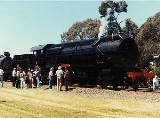
WAGR S Class
Encyclopedia
The WAGR S Class is a class of 1067mm narrow gauge 4-8-2
Mountain-type steam locomotives built by the Western Australian Government Railways
, with construction beginning in 1943. The class was initially intended for service on both passenger and goods services on the Eastern Goldfields Railway between Perth
and Kalgoorlie, though following the Second World War they worked primarily on the South West mainline. After suffering from a range of early problems (which led to controversy involving the designer Frederick Mills
) the class became highly popular and was very successful, remaining in service until the very end of steam operation in Western Australia in 1972.
The locomotives were given running-board nameplates and were named after West Australian mountains, following the tradition established 5 years earlier with the Pr Class pacifics, which were named after West Australian Rivers.
wheel arrangement, a configuration commonly used in Australia for heavy goods locomotives, smaller driving wheels giving increased power output but with reduced speed.
Numbers in brackets indicate initial number.
, S542 "Bakewell" is plinthed at East Perth Railway Terminal, once the site of the East Perth Locomotive Depot. S547 "Lindsay", is preserved on the Bellarine Peninsula Railway
in Victoria.
4-8-2
Under the Whyte notation for the classification of steam locomotives, 4-8-2 represents the wheel arrangement of four leading wheels on two axles , eight powered and coupled driving wheels on four axles, and two trailing wheels on one axle...
Mountain-type steam locomotives built by the Western Australian Government Railways
Western Australian Government Railways
Western Australian Government Railways was most common name of the Western Australian government rail transport authority from 1890 to 1976. It is, in its current form, known as the Public Transport Authority of Western Australia....
, with construction beginning in 1943. The class was initially intended for service on both passenger and goods services on the Eastern Goldfields Railway between Perth
Perth, Western Australia
Perth is the capital and largest city of the Australian state of Western Australia and the fourth most populous city in Australia. The Perth metropolitan area has an estimated population of almost 1,700,000....
and Kalgoorlie, though following the Second World War they worked primarily on the South West mainline. After suffering from a range of early problems (which led to controversy involving the designer Frederick Mills
Frederick Mills (engineer)
Frederick Mills was Chief Mechanical Engineer of the Western Australian Government Railways from 1940 until his death in 1949...
) the class became highly popular and was very successful, remaining in service until the very end of steam operation in Western Australia in 1972.
The locomotives were given running-board nameplates and were named after West Australian mountains, following the tradition established 5 years earlier with the Pr Class pacifics, which were named after West Australian Rivers.
Details of Design
The S Class locomotives were built as Mountain types, with a 4-8-24-8-2
Under the Whyte notation for the classification of steam locomotives, 4-8-2 represents the wheel arrangement of four leading wheels on two axles , eight powered and coupled driving wheels on four axles, and two trailing wheels on one axle...
wheel arrangement, a configuration commonly used in Australia for heavy goods locomotives, smaller driving wheels giving increased power output but with reduced speed.
Livery and Numbering
List of Names and NumbersNumbers in brackets indicate initial number.
- S 541 "Bruce" (S 476)
- S 542 "Bakewell" (S 477)
- S 543 "Brockman" (S 478)
- S 544 "Hallowell"
- S 545 "Dale"
- S 546 "Egerton"
- S 547 "Lindsay"
- S 548 "Gardner"
- S 549 "Greenmount"
- S 550 "Hardie"
Background
In the 1920s and 30's the West Australian rail systems were thoroughly run down. The vast majority of locomotives were well past their useful service life and many were badly in need of repairs. The P and Pr Class pacifics had helped alleviate pressure on aging passenger locomotives when introduced in 1924 and 1938 respectively, but more powerful machines were needed.Later History
Three examples have survived into preservation. S549 "Greenmount" is preserved in working condition by Rail Heritage Western AustraliaRail Heritage WA
Rail Heritage WA is the local trading name of the Australian Railway Historical Society Inc.It is the owner and manager of the Bassendean based Western Australia Rail Transport Museum....
, S542 "Bakewell" is plinthed at East Perth Railway Terminal, once the site of the East Perth Locomotive Depot. S547 "Lindsay", is preserved on the Bellarine Peninsula Railway
Bellarine Peninsula Railway
The Bellarine Railway is a volunteer-operated steam-driven tourist railway located in Victoria, Australia. It operates on a 16 km section of a formerly disused branch line on the Bellarine Peninsula between the coastal town of Queenscliff and Drysdale, near Geelong.- History as a working...
in Victoria.

